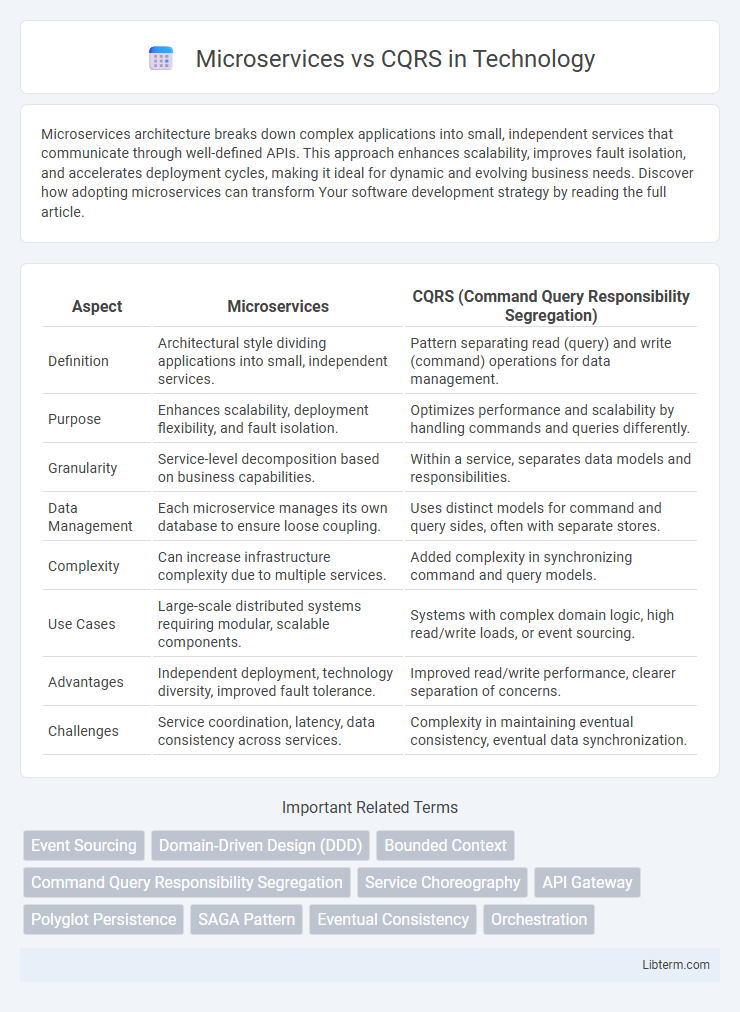Microservices architecture breaks down complex applications into small, independent services that communicate through well-defined APIs. This approach enhances scalability, improves fault isolation, and accelerates deployment cycles, making it ideal for dynamic and evolving business needs. Discover how adopting microservices can transform Your software development strategy by reading the full article.
Table of Comparison
| Aspect | Microservices | CQRS (Command Query Responsibility Segregation) |
|---|---|---|
| Definition | Architectural style dividing applications into small, independent services. | Pattern separating read (query) and write (command) operations for data management. |
| Purpose | Enhances scalability, deployment flexibility, and fault isolation. | Optimizes performance and scalability by handling commands and queries differently. |
| Granularity | Service-level decomposition based on business capabilities. | Within a service, separates data models and responsibilities. |
| Data Management | Each microservice manages its own database to ensure loose coupling. | Uses distinct models for command and query sides, often with separate stores. |
| Complexity | Can increase infrastructure complexity due to multiple services. | Added complexity in synchronizing command and query models. |
| Use Cases | Large-scale distributed systems requiring modular, scalable components. | Systems with complex domain logic, high read/write loads, or event sourcing. |
| Advantages | Independent deployment, technology diversity, improved fault tolerance. | Improved read/write performance, clearer separation of concerns. |
| Challenges | Service coordination, latency, data consistency across services. | Complexity in maintaining eventual consistency, eventual data synchronization. |
Introduction to Microservices and CQRS
Microservices architecture divides applications into small, independent services that communicate through APIs, enhancing scalability and flexibility. Command Query Responsibility Segregation (CQRS) separates read and write operations into distinct models, optimizing performance and data consistency. Combining Microservices with CQRS enables efficient handling of complex business domains by specializing services and improving data management.
Core Concepts of Microservices
Microservices architecture divides applications into small, independent services that communicate through APIs, enabling modularity and scalability. Each microservice encapsulates specific business capabilities, maintaining its own database to ensure data autonomy and reduce coupling. This decentralization contrasts with CQRS, which separates read and write operations within a single service for optimized performance and complexity management.
Fundamentals of CQRS Architecture
CQRS (Command Query Responsibility Segregation) architecture divides a system into two distinct parts: command side handles data modification, while query side focuses on data retrieval, promoting scalability and performance optimization in microservices. This separation enables microservices to adopt specialized data models and storage tailored for write and read operations, reducing complexity and improving responsiveness. CQRS supports event-driven communication within microservices, enhancing eventual consistency and facilitating complex domain logic implementation.
Key Differences: Microservices vs CQRS
Microservices is an architectural style that structures an application as a collection of loosely coupled services, each responsible for a specific business domain, while CQRS (Command Query Responsibility Segregation) is a design pattern that separates read and write operations to optimize performance and scalability. Microservices emphasize service decomposition and independent deployment, whereas CQRS focuses on the segregation of data modification commands from query operations within a system. Key differences include scope--Microservices span the entire application architecture, while CQRS applies to data handling within services--and purpose, where Microservices aim for modularity and fault isolation, and CQRS enhances data consistency and query efficiency.
When to Use Microservices
Microservices architecture is ideal for complex, large-scale applications requiring independent deployment, scalability, and fault isolation across multiple services. It works best when development teams are distributed, allowing parallel work streams and quicker iterations, particularly in domains that demand frequent updates and diverse technology stacks. Microservices also suit scenarios where fine-grained service boundaries aligned with business capabilities improve maintainability and facilitate continuous delivery.
Best Use Cases for CQRS
CQRS is best suited for complex domains with distinct read and write workloads, such as e-commerce platforms where product catalog searches require fast queries while order management demands consistent transactional processing. Event-driven systems and applications with high scalability needs benefit from CQRS by enabling separate scaling of read and write operations, reducing contention and improving performance. Microservices utilizing CQRS can achieve better separation of concerns, supporting independently deployable components that handle command and query responsibilities more efficiently than monolithic services.
Combining Microservices and CQRS
Combining microservices and CQRS enhances system scalability and maintainability by separating command and query responsibilities within each microservice, enabling independent scaling of read and write workloads. This approach leverages event-driven architectures, where write operations produce events consumed asynchronously by read models, ensuring eventual consistency and optimized performance. Implementing CQRS within microservices supports complex business domains by isolating data models and reducing coupling, facilitating agile development and deployment cycles.
Challenges in Implementation
Implementing microservices with CQRS introduces challenges like data consistency management between Command and Query models, increased system complexity, and the requirement for robust inter-service communication patterns. Developers must address eventual consistency, synchronize event sourcing mechanisms, and ensure scalability without compromising performance. Proper partitioning of commands and queries, along with comprehensive monitoring, is essential to mitigate latency and maintain data integrity across distributed components.
Scalability and Maintainability Comparison
Microservices architecture enhances scalability by enabling independent deployment and scaling of services, minimizing the impact of changes on the entire system. CQRS (Command Query Responsibility Segregation) improves maintainability through the separation of read and write operations, allowing optimized scaling strategies for different workloads. Combining microservices with CQRS results in a flexible, scalable, and maintainable system by isolating service responsibilities and optimizing data flow management.
Choosing the Right Approach for Your Project
Microservices architecture enables building scalable, independently deployable services focused on business capabilities, while CQRS (Command Query Responsibility Segregation) separates read and write operations for complex domains needing optimized performance and scalability. Selecting the right approach depends on project complexity, data consistency requirements, and team expertise; microservices suit modular, large-scale applications, whereas CQRS is ideal for systems demanding distinct command and query handling and eventual consistency. Evaluating domain complexity and deployment constraints ensures an architecture tailored to project goals and maintainability.
Microservices Infographic

 libterm.com
libterm.com